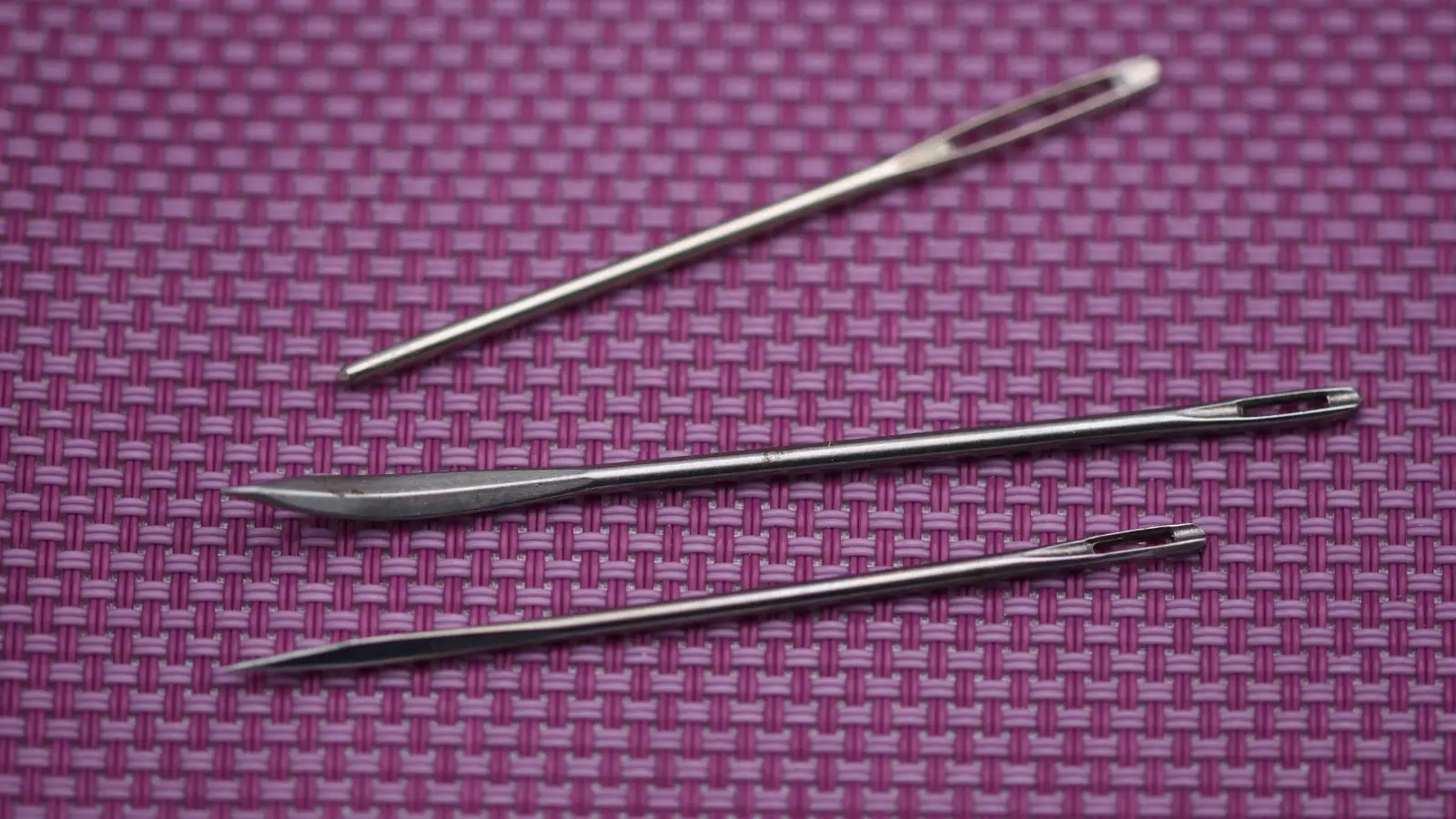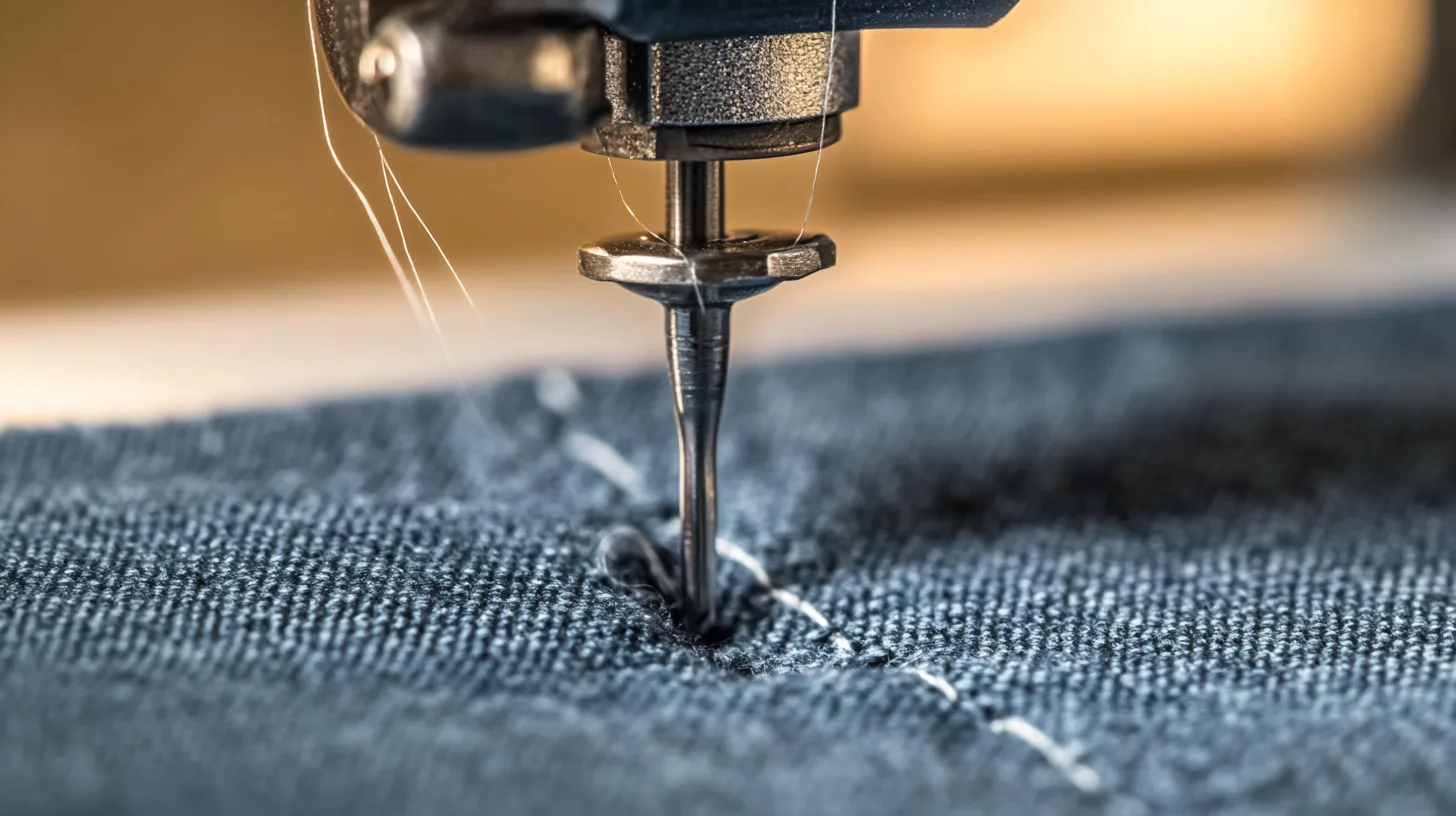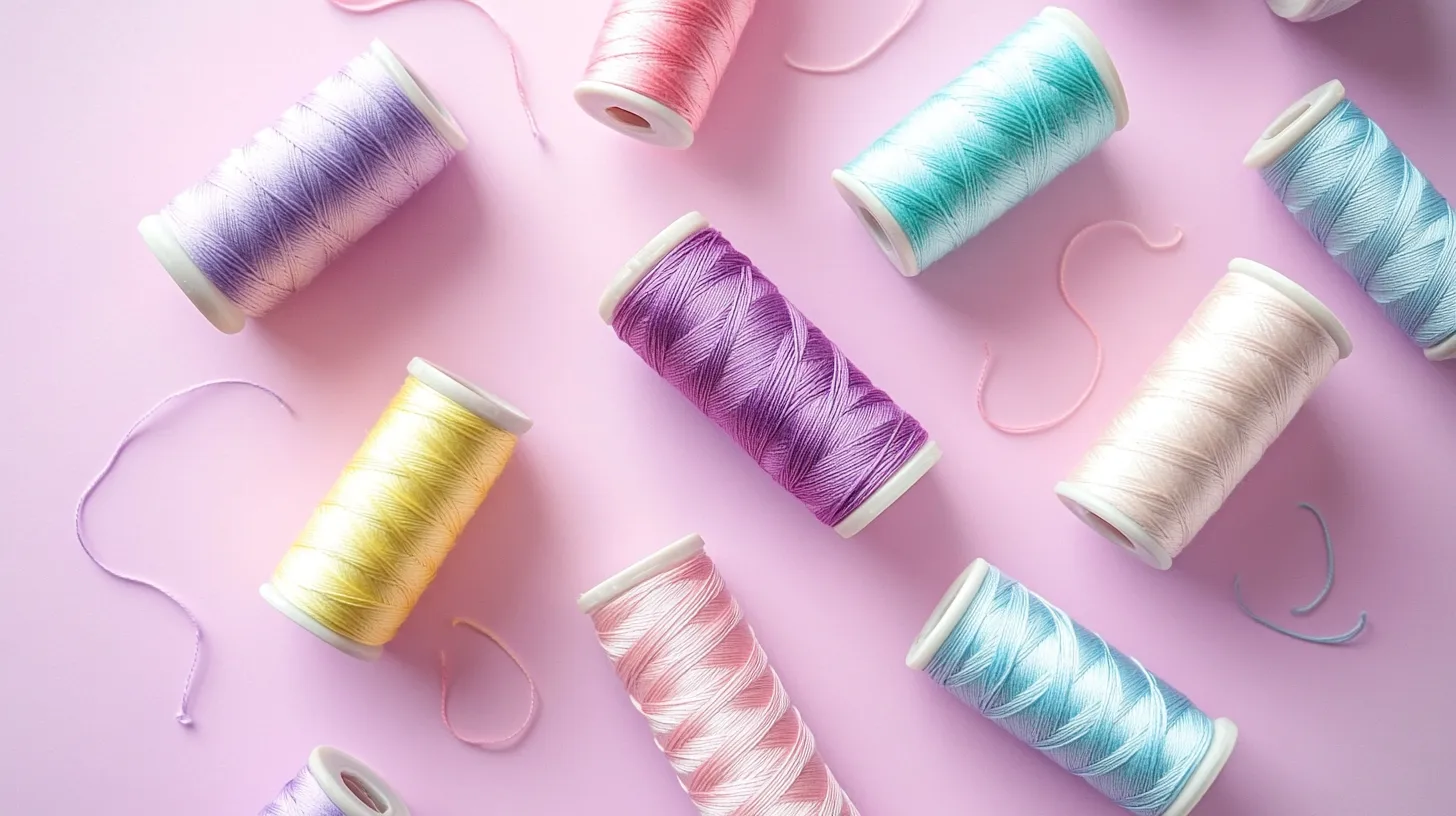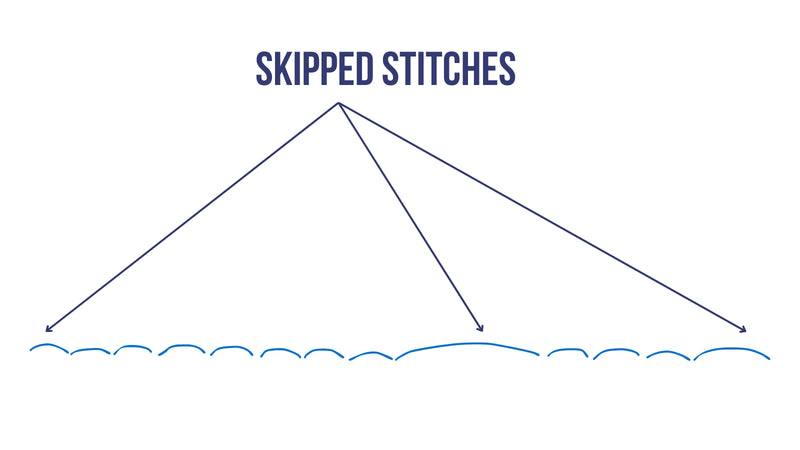You're not alone if you've ever been frustrated by your sewing machine skipping stitches. This common issue can disrupt your projects and leave you wondering what's wrong. It often boils down to a few key factors, such as the type and condition of your needle, thread tension, and even the cleanliness of your machine.
Before you throw in the towel, it's worth exploring these elements to get to the root of the problem. So, what exactly should you be looking at to fix those pesky skipped stitches?
Key Takeaways
- Using an incorrect needle type or size can cause skipped stitches.
- Improper needle insertion affects the thread-catching mechanism.
- Dust and lint accumulation can obstruct moving parts, leading to skips.
- Unbalanced thread tension results in inconsistent stitches.
- Uneven bobbin winding creates tension problems and skipped stitches.
Definition of Skipped Stitches
Skipped stitches happen when your sewing machine fails to form a proper stitch, resulting in gaps where the upper and bobbin threads don't connect. This can create bald spots in your stitching, making the stitch length appear inconsistent.
Common Signs of Skipped Stitches
Understanding the definition of skipped stitches lays the foundation for recognizing the common signs of this issue.
When skipped stitches occur, you'll notice inconsistent stitch sizes and gaps in your stitching. If your stitch length is set to 2.5mm but appears as 5mm, it's a clear sign of skipped stitches.
Look out for visible thread loops on the fabric surface, as these are also signs of skipped stitches.
Why Is My Sewing Machine Skipping Stitches? Common Causes
Let's explore these common causes to help you troubleshoot and fix your machine.
1. Incorrect Sewing Machine Needle

If you use an incorrect needle type, such as a standard needle, on knit fabrics, you'll likely encounter skipped stitches.
The needle size matters, too; mismatched needle and thread sizes can cause issues. Regularly replace your needle, as a dull needle after about 8 hours of sewing can impair stitch quality.
A bent needle is another common culprit. It'll misalign the thread-catching mechanism and cause skipped stitches.
2. Improper Needle Insertion

A common cause of skipped stitches is improper needle insertion. If your needle isn't fully seated in the needle bar, your machine can't form stitches correctly, leading to skipped stitches.
When the needle is at the wrong angle, it may not align with the hook, causing the hook to miss the thread loop.
Plus, a loose needle in the needle bar can wobble during operation, resulting in inconsistent thread catching.
3. Poor Stitching Technique
Your stitching technique can also impact whether your sewing machine is skipping stitches.
Sewing too quickly can result in inconsistent feed, which causes the machine to miss the thread loop, leading to skipped stitches.
Pulling the fabric while sewing disrupts stitch formation. This often results in the needle missing the thread loop.
Additionally, using lightweight or slippery fabrics without proper stabilization can complicate the process and increase the chances of skipped stitches.
4. Dirty Machine

A dirty machine might be the hidden culprit when your sewing machine starts skipping stitches.
Lint can accumulate in crucial areas like the bobbin area, feed dogs, and around the needle, obstructing moving parts.
5. Tension Issues
Tension issues are a frequent cause of skipped stitches in sewing machines. When the tension between the upper and bobbin threads isn't balanced, your stitches can become weak or inconsistent.
If you notice puckering or bunching on either side of the fabric, it's a sign you need to adjust the tension. Always refer to your sewing machine manual for specific tension settings.
6. Bobbin Problems
Bobbin problems are often the leading cause of skipped stitches. An improperly threaded bobbin might create tension imbalances between the upper and lower threads, resulting in stitching errors.
Make sure your bobbin is correctly inserted and aligned. A misaligned bobbin can disrupt the thread's feeding mechanism.
Using the wrong type of bobbin for your machine can also lead to compatibility issues affecting stitch formation.
Lastly, don't forget to check for dirt and lint buildup in the bobbin area. These can obstruct the movement of the bobbin case.
7. Fabric and Thread Issues

In addition to bobbin issues, fabric and thread choices impact your sewing machine's performance.
Using low-quality or damaged thread can lead to skipped stitches because the thread may not feed properly.
Thread thickness should match the needle size to maintain proper tension. Specialty thread that's not compatible with your machine can also cause complications.
Additionally, lint built from sewing fabrics that produce high amounts of lint can obstruct the machine, leading to skipped stitches.
Always match your materials to your project's needs.
Troubleshooting Steps for Skipped Stitches
After learning these common issues, let's start troubleshooting skipped stitches.
Check and Change the Needle
Skipped stitches frequently occur when the needle is dull, bent, or damaged. The first step is to replace the needle.
Always use the correct size needle for your fabric and the type of thread you're using. For instance, select a ballpoint needle for knits and a universal needle for woven fabrics. Ensure the needle is properly seated to avoid stitching issues.
Regular needle replacement, ideally every 8 hours of sewing, keeps your machine in top condition. If skipped stitches persist, inspect the needle for any visible damage. Even slight bends can disrupt the thread hooking mechanism and require immediate replacement.
Adjust Tension Settings
If you encounter skipped stitches, it's essential to check and adjust both the upper and bobbin thread tensions.
First, consult your sewing machine manual for recommended settings for your fabric type. Set the tension to the manufacturer's default, and then make small adjustments as needed.
Testing on a scrap piece of fabric helps ensure balanced stitching before starting your main project. Also, regularly inspect the tension settings, as they can shift due to fabric thickness, thread type, or needle changes.
Clean and Rethread the Machine
Cleaning and rethreading the machine is one of the most effective troubleshooting steps.
Thoroughly clean around the needle plate, bobbin area, and feed dogs to remove lint and debris.
Next, rethread the machine, ensuring the upper thread is properly seated in the tension discs and follows the correct path from the spool to the needle.
Loosen the tension before rethreading to help the thread seat correctly, maintaining consistent tension during sewing.
These steps often resolve issues and enhance your machine's performance.
Verify Bobbin Threading
One crucial step in troubleshooting skipped stitches is to verify the bobbin threading.
First, ensure your bobbin is threaded correctly. Check that the bobbin is wound evenly and not overfilled. Uneven winding can cause tension issues, affecting stitch formation.
Also, make sure the bobbin is inserted in the correct orientation. A misplaced bobbin disrupts the thread's path.
Inspect the bobbin case for dirt or lint buildup, which can impede the bobbin's movement and cause stitching problems.
Always use the recommended bobbin type for your machine. Incompatible bobbins can lead to malfunctions and skipped stitches.
Call a Professional
If basic troubleshooting methods haven't resolved your sewing machine's skipped stitches, it might be time to call a professional.
Professional technicians will inspect for hidden wear and tear and address issues not immediately visible to you. Many sewing machine manufacturers also offer customer support to guide you or recommend repair services.
Additionally, joining sewing communities can connect you with experienced sewists who can recommend trusted professionals.
How to Prevent Skipped Stitches
To prevent skipped stitches, follow these steps to keep your machine running smoothly.
- Clean Machine: Regularly clean the machine, especially around the bobbin area and feed dogs, to remove lint and debris.
- Check Needle: Ensure the needle is the correct type and size for your fabric. Replace dull or damaged needles.
- Thread Quality: Use high-quality thread suitable for your fabric. Avoid old or frayed threads.
- Thread Tension: Adjust the upper and lower thread tension as needed. Too tight or too loose can cause skipped stitches.
- Feed Dogs: Ensure the feed dogs are up and functioning properly to move the fabric evenly.
- Sewing Speed: Maintain a steady speed while sewing. Going too fast can lead to skipped stitches.
- Stitch Length and Width: Adjust stitch length and width according to the fabric type to avoid issues.
- Check Bobbin: Ensure the bobbin is wound evenly and inserted correctly in the machine.
Conclusion
Tackling skipped stitches is all about proactive care and troubleshooting. Using the correct needle, ensuring proper threading, and maintaining your machine will reduce the chances of those frustrating bald spots.
Don't forget to balance thread tension and inspect the bobbin regularly. Consistent maintenance and high-quality materials will keep your sewing projects smooth and flawless.
Stay diligent, and your sewing machine will reward you with perfect stitches!
Learn more sewing tips and fabric knowledge on the Longan Craft Blog, and dive into the fabric world with Longancraft!
FAQs
How Do I Fix a Sewing Machine That Skips Stitches?
First, replace the needle and ensure it's properly seated. Clean your machine, especially the feed dogs, needle plate, and bobbin area. Adjust the tension settings for your fabric and experiment with different needle types and sizes.
Can Tension Cause Skipped Stitches?
Yes, tension can definitely cause skipped stitches. If your machine's tension is too tight or too loose, it disrupts stitch formation. Regularly adjust the tension according to your fabric type to maintain consistent, even stitches.
What Tension Should My Sewing Machine Be On?
Start your tension around 4, then adjust based on your fabric. Lightweight fabrics may need a 2-3 setting, while heavier fabrics might require 5-6. Always test on scrap fabric first and consult your machine's manual.
What Causes Skipped Stitches in a Seam?
Skipped stitches in a seam usually occur because of a bent needle, the wrong needle type, or incorrect tension. For better results, regularly change your needle, clean your machine, and adjust the tension to match your fabric.


0 comments